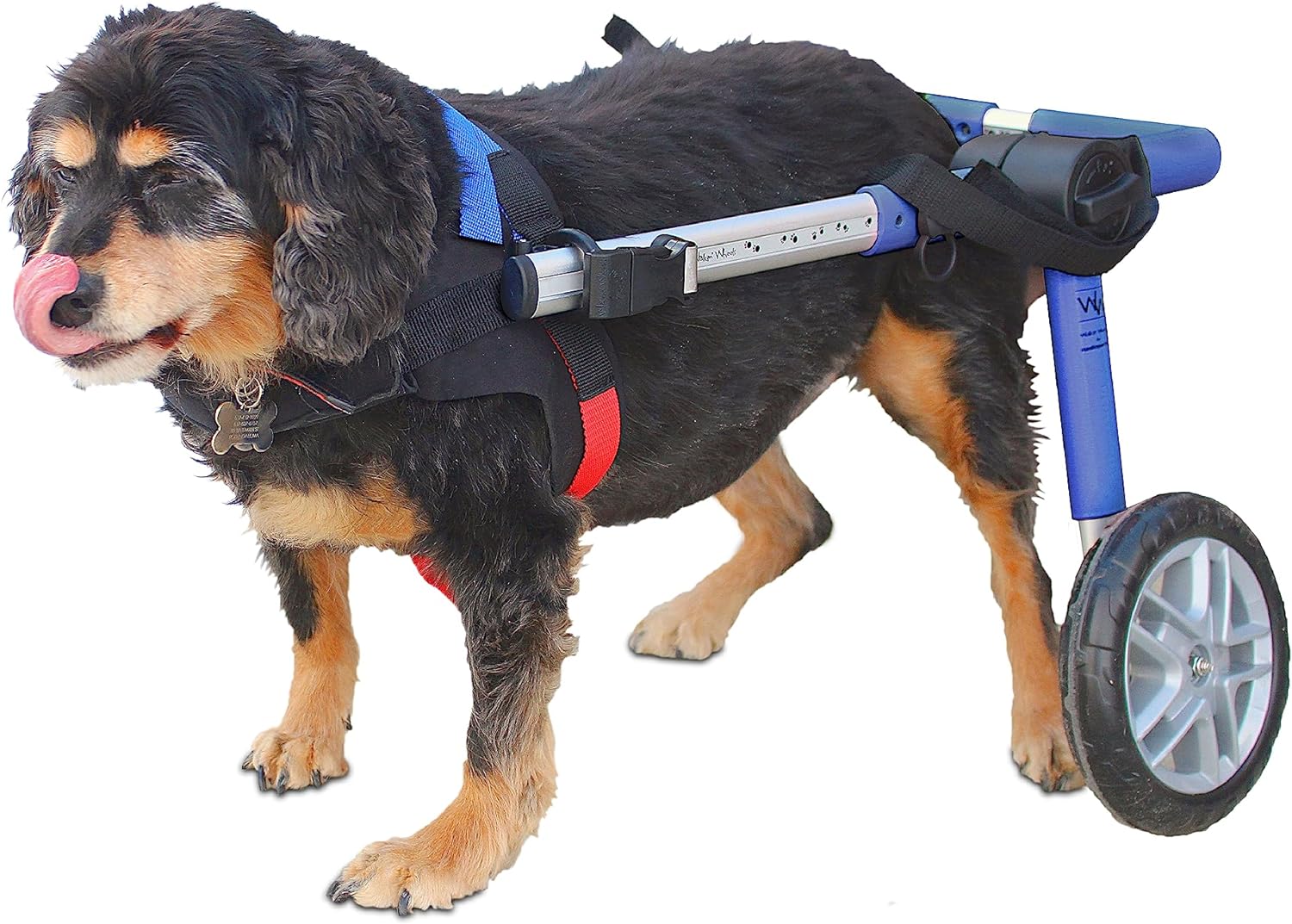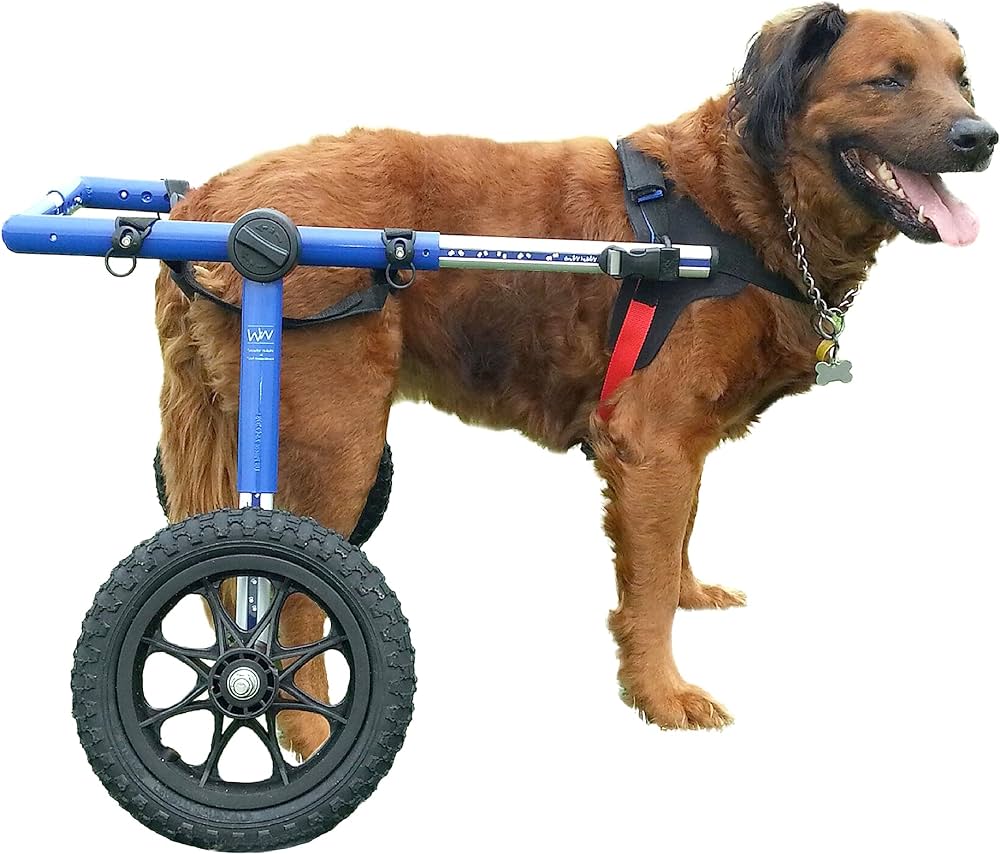Imagine a world where every dog, regardless of their physical limitations, can experience the joy of running and playing. With the help of dog wheelchairs, also known as doggie carts, more and more dogs are being given the opportunity to regain their mobility. But how long can a dog comfortably stay in a dog wheelchair? In this article, we’ll explore the factors to consider and provide some guidance on ensuring your furry friend’s comfort and well-being while using a dog wheelchair.
What is a dog wheelchair?
A dog wheelchair, also known as a dog cart or dog mobility device, is a specially designed apparatus that helps dogs with mobility issues regain their independence and improve their quality of life. It is essentially a wheeled frame that supports the hind legs or all four legs of a dog, depending on their level of mobility.
Definition of a dog wheelchair
A dog wheelchair is a rehabilitation tool that allows dogs with conditions such as spinal injuries, arthritis, hip dysplasia, degenerative myelopathy, or neurological disorders to move around comfortably and freely. It provides support to their weak or paralyzed limbs, enabling them to walk, run, and play.
Purpose of a dog wheelchair
The primary purpose of a dog wheelchair is to enable dogs with mobility difficulties to live happy, active lives despite their physical limitations. It helps in reducing pain, improving muscle strength, preventing further deterioration of the condition, and boosting the overall well-being of the dog.
Types of dog wheelchairs
There are various types of dog wheelchairs available, each designed to meet the specific needs of different breeds, sizes, and levels of immobility. Some common types include rear support wheelchairs, full-support wheelchairs, front-wheel carts, and quad carts. It is important to choose the right type of wheelchair based on the dog’s individual needs and condition.
Factors affecting the duration in a dog wheelchair
Several factors play a crucial role in determining the duration a dog can comfortably spend in a wheelchair. These factors need to be considered to ensure the well-being and long-term mobility of the dog.
Dog’s mobility and strength
The level of mobility and strength of the dog is a key factor in determining how long they can comfortably use a wheelchair. Dogs with more strength and mobility may be able to spend longer periods in the wheelchair, while those with severe mobility issues may require shorter durations.
Dog’s size and weight
The size and weight of the dog can impact the duration of wheelchair usage. Larger and heavier dogs may experience more strain on their muscles and joints, necessitating shorter periods in the wheelchair to avoid excessive fatigue or discomfort.
Comfort and fit of the wheelchair
The comfort and fit of the wheelchair are crucial for a dog’s well-being. If the wheelchair is uncomfortable or ill-fitting, it can lead to pressure sores, abrasions, or other skin issues. A properly fitting wheelchair that provides adequate support and cushioning can enhance the dog’s comfort during usage.
Health condition of the dog
The specific health condition of the dog, such as the severity of their injury or disease, may impact the recommended duration in a wheelchair. Dogs with acute injuries or conditions may require more rest and shorter usage periods, while those with less severe issues may be able to spend more time in the wheelchair.
Adaptation period
The adaptation period is important for dogs transitioning to using a wheelchair. Initially, dogs may require shorter durations in the wheelchair to get accustomed to the device and build up their strength. Gradually increasing the time spent in the wheelchair as the dog adjusts is essential for their comfort and well-being.

Recommended duration for dog wheelchair usage
Determining the appropriate duration of wheelchair usage for a dog depends on several factors, including professional guidance and individual dog’s needs.
Guidelines from veterinarians
Consulting with a veterinarian is crucial in establishing the recommended duration for a dog’s wheelchair usage. Veterinarians can assess the dog’s specific condition, examine their progress, and provide guidance on the appropriate duration based on the dog’s health and response to the wheelchair.
Individual dog’s needs
Every dog is unique, and their mobility needs vary. Observing the dog’s behavior and listening to their cues can help determine the optimal duration. Some dogs may require shorter periods to prevent fatigue, while others may thrive with longer durations. It is important to tailor the usage according to the dog’s specific requirements.
Balancing rest and mobility
Striking the right balance between rest and mobility is crucial for a dog’s overall well-being. While regular mobility is essential for muscle strength and joint health, adequate rest periods are necessary to prevent exhaustion and overexertion. Alternating between time spent in the wheelchair and rest breaks helps maintain a healthy balance.
Avoiding excessive strain
Excessive strain on a dog’s muscles and joints should be avoided to prevent further injury or discomfort. Monitoring the dog for signs of exhaustion, discomfort, or reluctance to use the wheelchair can indicate the need for shorter duration. Prioritizing the dog’s comfort and adjusting the duration accordingly is vital to prevent any adverse effects.
Monitoring the dog’s well-being
Continuous monitoring of the dog’s well-being is crucial to ensure their safety and comfort throughout their wheelchair usage.
Regular check-ups with a veterinarian
Regular check-ups with a veterinarian are essential to assess the dog’s progress, identify any issues, and make necessary adjustments to the wheelchair usage duration. Veterinarians can provide valuable insights and recommendations based on the dog’s overall health and condition.
Observing signs of discomfort or fatigue
As a dog owner, it is important to pay close attention to signs of discomfort or fatigue exhibited by the dog during and after wheelchair usage. Signs may include excessive panting, whimpering, restlessness, or an unwillingness to continue using the wheelchair. If any of these signs are observed, it is crucial to assess the duration and make adjustments as necessary.
Adjustments to the wheelchair
Making adjustments to the wheelchair can significantly impact the dog’s comfort and usage duration. This may include ensuring proper padding and cushioning, adjusting the harness or straps, or modifying the fit to reduce any pressure points. Regularly inspecting and adjusting the wheelchair as needed is essential for the dog’s well-being.

Building strength and mobility
To improve the dog’s overall strength, mobility, and endurance, certain measures can be taken alongside wheelchair usage.
Physical therapy exercises
Engaging the dog in physical therapy exercises recommended by a veterinarian or a canine rehabilitation specialist can help build strength in the supporting muscles. These exercises may include stretching, swimming, hydrotherapy, or targeted muscle strengthening exercises.
Gradual increase in wheelchair usage time
Gradually increasing the duration of wheelchair usage over time allows the dog to build strength and adapt to the device. Starting with shorter durations and progressively increasing the duration as the dog gets stronger and more comfortable can minimize the risk of strain or exhaustion.
Strengthening the supporting muscles
In addition to wheelchair usage, exercises that target the muscles supporting the dog’s limbs can improve overall strength. Strengthening exercises, such as sit-to-stand or balancing exercises, can help the dog maintain stability and mobility outside of the wheelchair as well.
Providing breaks and rest
Ensuring the dog gets ample breaks and rest periods is crucial for their well-being and avoiding overstimulation or fatigue.
Ensuring proper rest periods
Creating a schedule that includes regular breaks for the dog to rest and recover is essential. These rest periods can be tailored based on the dog’s energy levels, fatigue, and overall tolerance to avoid pushing them past their limits.
Allowing the dog to walk or run without the wheelchair
Incorporating periods where the dog can walk or run without the wheelchair allows them to engage in natural movements and activities. This helps in maintaining muscle tone, joint mobility, and overall physical and mental stimulation. However, these activities should be supervised and take place in a safe and controlled environment.
Engaging in low-impact activities
Engaging the dog in low-impact activities, such as swimming, gentle walks, or interactive play sessions, during rest periods can provide mental and physical stimulation while minimizing strain on the dog’s body. These activities help to avoid prolonged sedentary periods and promote an active, healthy lifestyle.

Creating a comfortable environment
Ensuring a comfortable environment for the dog is essential to support their well-being during wheelchair usage.
Choosing appropriate surfaces for mobility
Selecting appropriate surfaces for the dog to move on can enhance their mobility experience. Smooth, non-slip surfaces provide better traction and reduce the risk of slips or falls. Avoiding rough or uneven terrain helps prevent discomfort and potential damage to the wheelchair or the dog’s limbs.
Proper padding and cushioning in the wheelchair
Having proper padding and cushioning in the wheelchair helps in distributing the dog’s weight evenly and minimizing any pressure points or discomfort. The padding should be checked regularly and replaced if it becomes worn or loses its supportive properties.
Temperature regulation
Maintaining an appropriate temperature is important for the dog’s comfort. Dogs in wheelchairs may be more susceptible to overheating or chilling, so ensuring they are in a temperature-controlled environment and providing appropriate protection from extreme weather conditions is crucial for their well-being.
Training and adapting to the wheelchair
Introducing a dog to a wheelchair requires patience, positive reinforcement, and gradual acclimation to reduce anxiety or fear.
Positive reinforcement training
Using positive reinforcement techniques, such as treats, praise, and rewards, helps create a positive association with the wheelchair. This encourages the dog to approach and accept the device willingly. Consistent and patient training builds trust and confidence, easing their adaptation to the wheelchair.
Gradual introduction to the wheelchair
Introducing the wheelchair slowly and gradually allows the dog to become familiar with the device without feeling overwhelmed. Starting with short sessions and increasing the duration gradually as the dog becomes more comfortable helps in building a positive association and reduces stress.
Rewarding and encouraging the dog
Consistently rewarding and encouraging the dog during wheelchair usage reinforces their confidence and motivation. Praising and rewarding them for their efforts help create a positive experience, making the dog more likely to enjoy using the wheelchair and maximizing their potential mobility.

Alternatives to wheelchair usage
In certain cases, wheelchair usage may not be the most suitable option or may not provide the desired outcomes. There are alternative approaches to consider.
Surgical interventions
Depending on the dog’s specific condition, surgical interventions may be an option to correct or improve mobility issues. Surgical procedures, such as joint replacements or spinal surgeries, can provide long-term solutions for certain conditions. Consulting with a veterinarian or a veterinary specialist is crucial in determining the appropriateness of surgical interventions.
Assistive devices
Assistive devices, such as slings, harnesses, or orthopedic braces, can provide additional support and mobility assistance to dogs with mild to moderate mobility impairments. These devices may help in improving stability, reducing pain, and allowing the dog to move around with minimal assistance.
Home modifications
Making modifications to the home environment can enhance the dog’s mobility and reduce reliance on a wheelchair. Installing ramps, non-slip surfaces, or removing obstacles that impede movement can enable the dog to navigate the living space more comfortably. Considering home modifications alongside wheelchair usage allows for greater independence and accessibility.
Consulting professionals
Consulting professionals is crucial when it comes to the well-being and care of a dog using a wheelchair.
Veterinarians
Veterinarians play a significant role in assessing the dog’s health condition, providing professional guidance, and monitoring their progress. Regular check-ups with a veterinarian ensure the dog’s specific needs are being addressed, and any adjustments required in the wheelchair usage can be made.
Canine rehabilitation specialists
Canine rehabilitation specialists specialize in physical therapy, rehabilitation exercises, and other treatments for dogs with mobility issues. They can provide tailored exercise plans, assist with muscle strengthening techniques, and offer valuable advice on maximizing the benefits of wheelchair usage.
Wheelchair manufacturers
Wheelchair manufacturers are an excellent resource for obtaining the right wheelchair for a dog’s specific needs. They can provide advice on the appropriate type and size of the wheelchair based on the dog’s breed, weight, and mobility requirements. Wheelchair manufacturers also offer support in terms of adjustments, repairs, and maintenance.
In conclusion, the duration a dog can spend in a wheelchair varies depending on several factors, including the dog’s mobility, size, comfort, health condition, and adaptation period. With proper monitoring, regular breaks and rest, strength-building exercises, and a comfortable environment, dogs can enjoy improved mobility and quality of life with the assistance of a wheelchair. Consulting professionals and considering alternatives when necessary ensure the best possible care and well-being for dogs with mobility difficulties.



